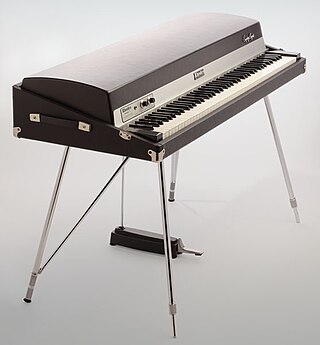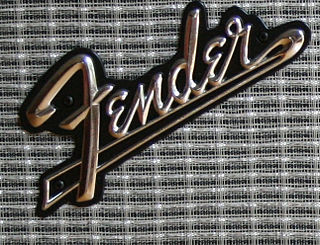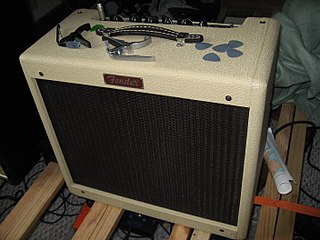Related Research Articles

The Rhodes piano is an electric piano invented by Harold Rhodes, which became popular in the 1970s. Like a conventional piano, the Rhodes generates sound with keys and hammers, but instead of strings, the hammers strike thin metal tines, which vibrate next to an electromagnetic pickup. The signal is then sent through a cable to an external keyboard amplifier and speaker.

Vox is a British musical equipment manufacturer founded in 1957 by Thomas Walter Jennings in Dartford, Kent, England. The company is most famous for making the Vox AC30 guitar amplifier, used by The Beatles, The Rolling Stones, The Kinks, The Yardbirds, Queen, Dire Straits, U2, and Radiohead; the Vox Continental electric organ, the Vox wah-wah pedal used by Jimi Hendrix, and a series of innovative electric guitars and bass guitars. Since 1992, Vox has been owned by the Japanese electronics firm Korg.

A guitar amplifier is an electronic device or system that strengthens the electrical signal from a pickup on an electric guitar, bass guitar, or acoustic guitar so that it can produce sound through one or more loudspeakers, which are typically housed in a wooden cabinet. A guitar amplifier may be a standalone wood or metal cabinet that contains only the power amplifier circuits, requiring the use of a separate speaker cabinet–or it may be a combo amplifier, which contains both the amplifier and one or more speakers in a wooden cabinet. There is a wide range of sizes and power ratings for guitar amplifiers, from small, lightweight practice amplifiers with a single 6-inch speaker and a 10-watt amp to heavy combo amps with four 10-inch or four 12-inch speakers and a 100-watt amplifier, which are loud enough to use in a nightclub or bar performance.

The Fender Musical Instruments Corporation is an American manufacturer and marketer of musical instruments and amplifiers. Fender produces acoustic guitars, bass amplifiers and public address equipment; however, it is best known for its solid-body electric guitars and bass guitars, particularly the Stratocaster, Telecaster, Jaguar, Jazzmaster, Precision Bass, and the Jazz Bass. The company was founded in Fullerton, California, by Clarence Leonidas "Leo" Fender in 1946. Andy Mooney has served as the chief executive officer (CEO) since June 2015.

Mesa/Boogie is an American company in Petaluma, California, that manufactures amplifiers and other accessories for guitars and basses. It has been in operation since 1969.

Ampeg is a manufacturer best known for its bass amplifiers.

Fender amplifiers are electric instrument amplifiers produced by the Fender Musical Instruments Corporation. The first guitar amplifiers attributed to Leo Fender were manufactured by the K&F Manufacturing Corporation (K&F) between 1945 and 1946. Later, Fender began building its own line of electric guitars. Fender amplifiers would become favorites of guitarists like Jimi Hendrix, Eric Clapton, and Stevie Ray Vaughan, also known in these cases for playing Fender guitars.

SWR Sound Corporation was a specialist manufacturer of bass guitar amplifiers, preamps, speaker cabinets, and acoustic guitar amplifiers.
Boutique amplifier is a catch-all descriptor for any type of instrument amplifier that is typically hand built with the intention of being much better than the mass-produced variety offered by large companies. In the majority of cases, this is reflected in the price. Sometimes they are clones of older designs, often with minor improvements or alterations in layout or circuit design; sometimes they are new designs altogether.

The Fender Twin and Twin Reverb are guitar amplifiers made by Fender Musical Instruments Corporation. The Twin was introduced in 1952, two years before Fender began selling Stratocaster electric guitars. The amps are known for their characteristically clean tone.

This is a history of the equipment that the English rock band The Who used. It also notes their influence on the instruments of the time period.

The Blues Junior is a tube guitar amplifier introduced in 1995 by the Fender Musical Instrument Corporation. It is aimed at achieving the warm, tube-driven tone common in many styles of American blues and blues rock dating back to the 1950s, while remaining both portable and affordable. A popular amp, Fender have released numerous versions since its initial release, the most recent being the version IV in 2018. Fender also frequently releases limited editions of the Blues Junior, such as the Lacquered Tweed and the "80 Proof".
The Marshall Bluesbreaker is the popular name given to the Models 1961 and 1962 guitar amplifiers made by Marshall from 1964/65 to 1972.
The Fender Deluxe guitar amplifier is a range of non-reverb guitar amplifiers produced by Fender. The amplifiers were originally produced from early 1948 to 1966 and reissues are in current production. Its predecessor was the Fender Model 26 "Woodie" produced from 1946 to 1948.
In an amplifier, a presence control boosts the upper mid-range frequencies to make the sounds of voices and instruments with similar tonal ranges seem more "present".

The Marshall JTM45 amplifier is the first guitar amplifier produced by the British company Marshall. It was initially produced in 1963, and has been ranked among the most desirable of the company's amplifiers.
A tone stack is a specialized type of audio filter incorporated into the circuit of an audio amplifier to alter its frequency response. The term is primarily used in reference to instrument amplifiers such as guitar amplifiers.

Vintage musical equipment is older music gear, including instruments, amplifiers and speakers, sound recording equipment and effects pedals, sought after, maintained and used by record producers, audio engineers and musicians who are interested in historical music genres. While any piece of equipment of sufficient age can be considered vintage, the term is typically applied to instruments and gear from the 1970s and earlier. Guitars, amps, pedals, electric keyboards, sound recording equipment from the 1950s to 1970s are particularly sought after, while musical equipment from the 1940s and earlier is generally far more expensive and sought out mainly by museums or collectors to preserve historical equipment, rather than to perform with.
The Falcon (GA-19RVT) was a guitar amplifier made by Gibson Guitar Corporation in 1961. With the Falcon and a few other models, Gibson was ahead of Fender in bringing an amplifier with reverb on the market. In addition, the Falcon also had tremolo.
Tremolo, in electronics, is the variation in amplitude of sound achieved through electronic means, sometimes mistakenly called vibrato, and producing a sound somewhat reminiscent of flanging, referred to as an "underwater effect". A variety of means are available to achieve the effect. For further information about the use of tremolo in music, including notation, see Tremolo.
References
- ↑ Wheeler, Tom (2007). The Soul of Tone: Celebrating 60 Years of Fender Amps. Hal Leonard. p. 318. ISBN 9780634056130 . Retrieved 17 November 2012.
- ↑ . Brosnac, Donald (1987). The Amp Book: A Guitarist's Introductory Guide to Tube Amplifiers. Bold Strummer. pp. 27, 31. ISBN 9780933224056 . Retrieved 17 November 2012.
- ↑ McGowan, Chris (15 November 1980). "The Hills abound with Pro Sound Pioneers". Billboard . pp. 41–42. Retrieved 18 November 2012.